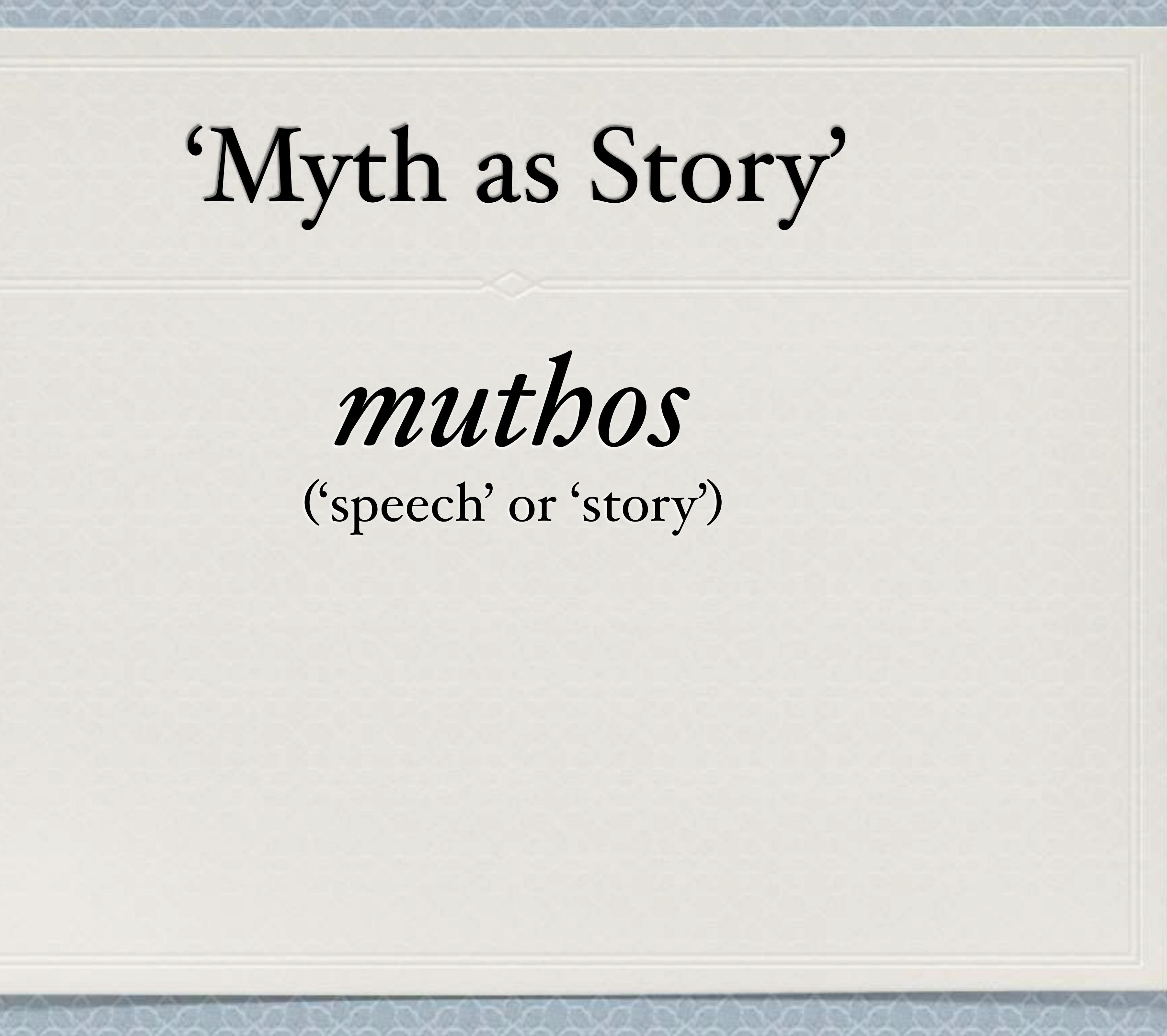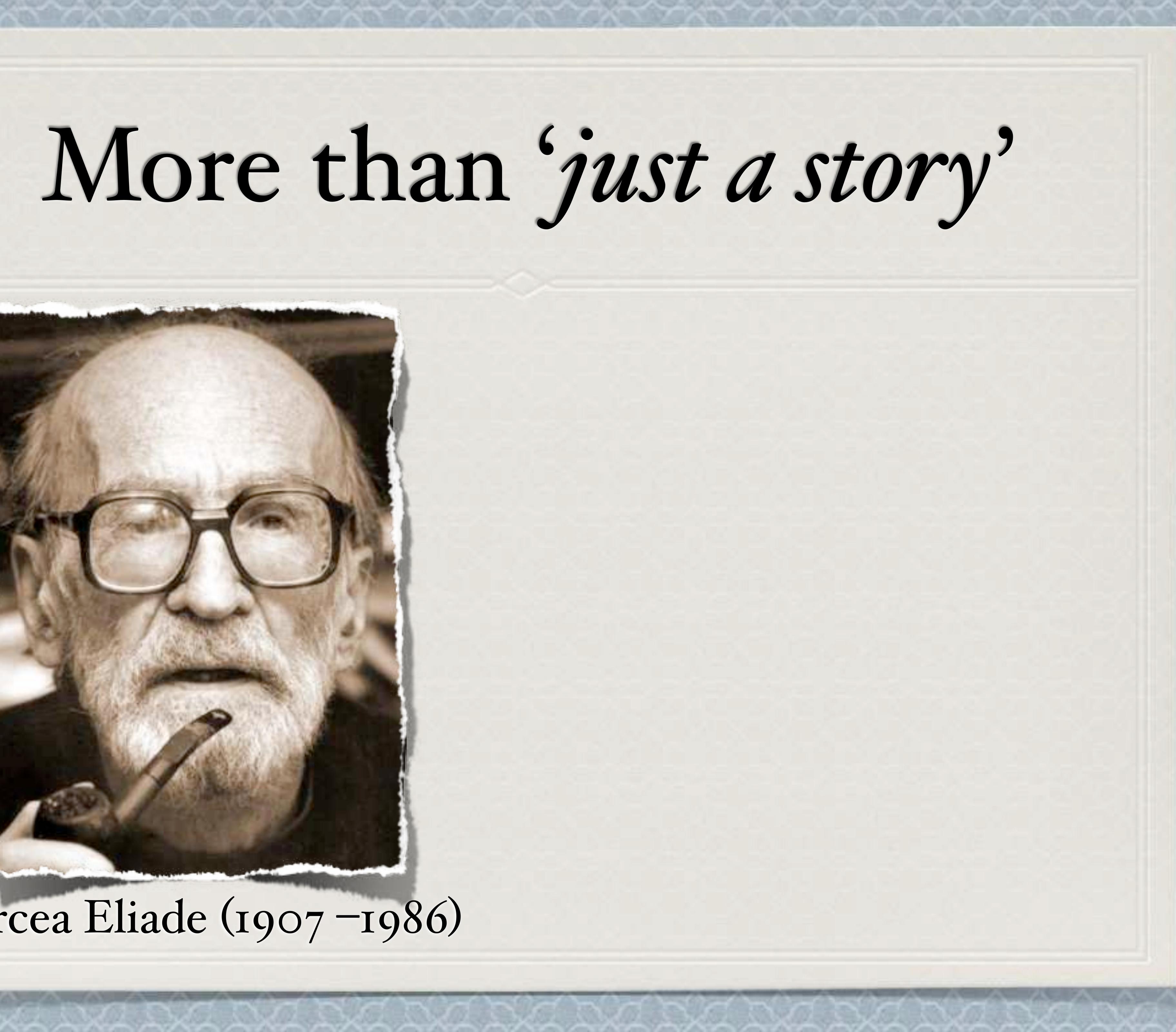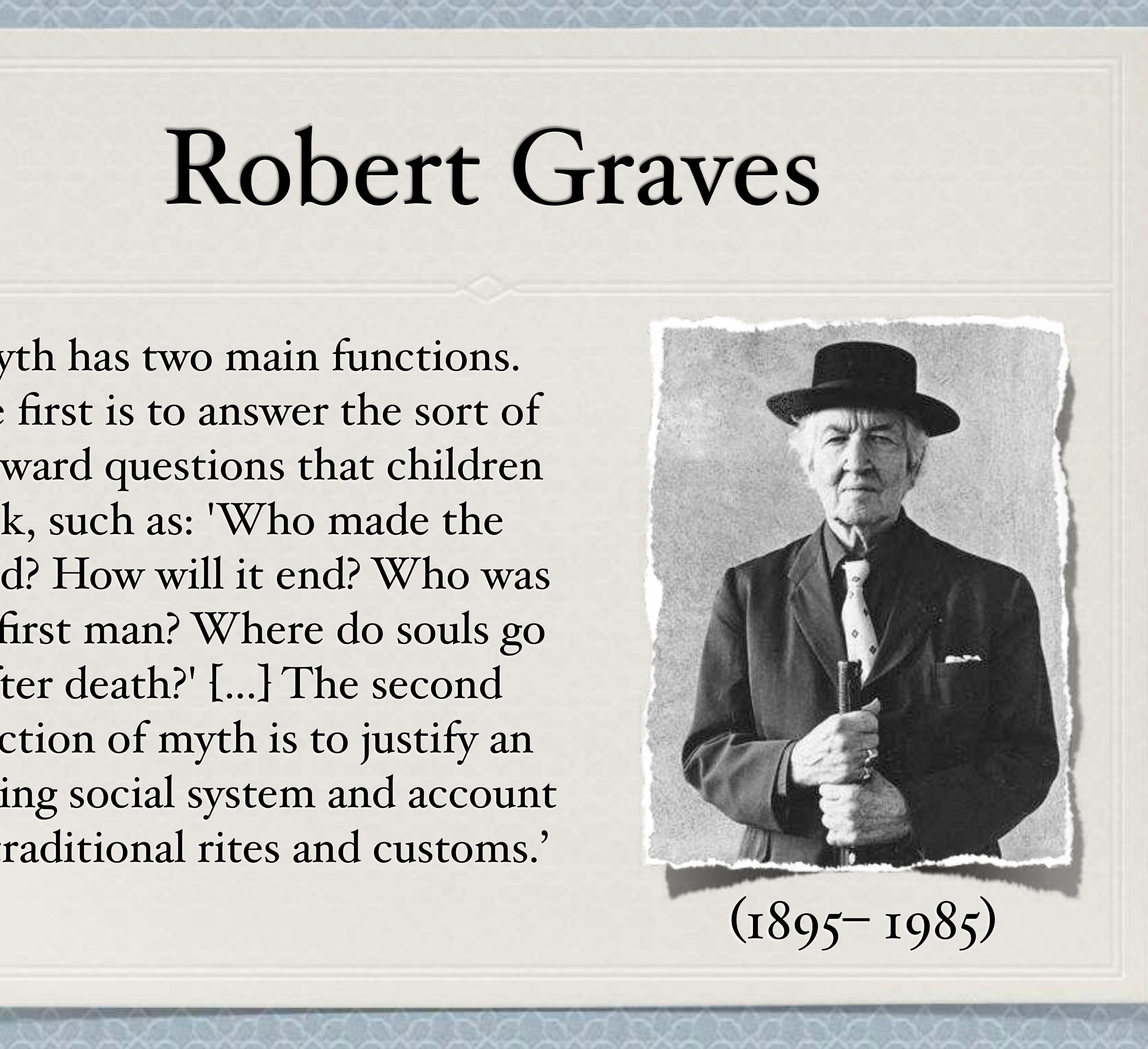What is Myth?

Sign up for access to the world's latest research
Abstract
AI
AI
This paper explores the essence of myth, defining it as a narrative that conveys sacred history, explains the origins of the world, and describes the relationship between humans and gods in creation. The relevance of these stories persists in contemporary society, showcasing the timeless nature of myth and its continued impact on culture.
Related papers
indigogroup.co.uk
A myth is a story that is sacred to a group of people; to those people, the story is true and concerns foundational events–from the origin and organization of the cosmos to the origin and organization of fundamental human institutions (examples: kingship, gender roles). In ...
2013
In search of a scientifically useful minimal definition of the term "myth", this article traces the development of the concept from the cultural environment of classical Greece, in which it was born, until its modern use in the framework of socio-anthropological studies. Of all the terms of the vocabulary of religious anthropology "myth'' is certainly the most used one. Unfortunately, its wide-spread use is directly proportional to its indeterminateness. Moreover, it regards not only the everyday lexis (what is exactly intended, when, for instance, people call an actor or a soccer player "mythic"?), but also academic communications: various authors can intend by this concept diametrically opposed things.
Myths are traditional tales which are shared by a group of people. Every culture has its own myths which transfer the beliefs of primitive people about the creation of the universe and its content. Knowledge, like a river flowing down a mountain, has a source. Thus, Myths are regarded as the first source of knowledge for the primitive people to acquaint themselves with the world around. The origin of the word myth and its different interpretations along with its uses has to be surveyed briefly for giving a complete idea about myth. This survey is an attempt to shed the light on the origin of the word myth, to review the different meanings of myth and to present into light the various uses of myth.
In The Challenge of Folklore to the Humanities, ed. Dan Ben-Amos, a special issue of Humanities 7(4), 14: 1-39, 2018
Myth has become a fundamental frame of reference for Western thinking. This paper explores the term and category " myth " from the perspective of folklore studies, with concern for the use of myth as a tool in research. The ways in which myth has been used in both academic and popular discourses are discussed. These are viewed in a historical perspective against the backdrop of the origins of the modern term. Attention is given to how historical patterns of use have encoded " myth " with evaluative stance-taking, building an opposition of " us " versus " them " into myth as something " other people " have, in contrast to us, who know better. Discussion then turns to approaching myth as a type of story. The consequences of such a definition are explored in terms of what it does or does not include; the question of whether, as has often been supposed, myth is a text-type genre, is also considered. Discussion advances to aesthetic evaluation at the root of modern discussions of myth and how this background informs the inclination to identify myth as a type of story on the one hand while inhibiting the extension of the concept to, for example, historical events or theories about the world or its origins, on the other. Approaching myth as a type of modeling system is briefly reviewed—an approach that can be coupled to viewing myth as a type of story. Finally, discussion turns to the more recent trend of approaching mythology through mythic discourse, and the consequences as well as the benefits of such an approach for understanding myth in society or religion. There are many different ways to define myth. The present article explores how different approaches are linked to one another and have been shaped over time, how our definition of myth and the way we frame the concept shape our thinking, and can, in remarkably subtle ways, inhibit the reflexive application of the concept as a tool to better understand ourselves.
Mythology can refer either to the collected myths of a group of people-their body of stories which they tell to explain nature, history, and customs [1] -or to the study of such myths. [2] As a collection of such stories, mythology is an important feature of every culture. Various origins for myths have been proposed, ranging from personification of natural phenomena to truthful or hyperbolic accounts of historical events, to explanations of existing ritual. Although the term is complicated by its implicit condescension, mythologizing is not just an ancient or primitive practice, as shown by contemporary mythopoeia such as urban legends and the expansive fictional mythoi created by fantasy novels and Japanese manga. A culture's collective mythology helps convey belonging, shared and religious experience, behavioral models, and moral and practical lessons.
International Journal of English Language, Literature in Humanities, 2021
Myth can vaguely be said to have come into existence due to the urge of seeking answers to curious mind about the universe, nature, man or can be the result emerged from the need for religious stability of societal control using certain customs and rituals. Myth when looked with a proper outlook can be termed as meaningful, for it beholds metaphysics, the branch of philosophy that deals with the first source of things, including intangible concepts such as being, identity, time and space in its primary sense while developing close proximity to immediate perception of reality. The universal belief system is held and disseminated with a certain amount of pompousness in language and settings, based on mythic stories of a clan or cult. The purpose of this paper is to establish mythic tales as a vital ingredients for posterity to look upon and validate that the re-reading of mythic tales into fiction opens up a variety of possibilities, including: various perspectives and dimensions to the same story portrayed in/as legendary texts. Humanistic consideration is brought about by individual representation. There are a variety of ways to look at the philosophy that has been passed down through the generations through stories. Keywords: Myth, Mythic Tales, Re-Interpretation, Sociological aspect, Pedagogical value.
Humaniora. Czasopismo Internetowe
The present paper is an introduction to the debate on the contemporary methodology of research on myths. I attempt herein to elucidate the essence of myth, with the attempt being carried out in two parts. In the first part, I overview a history of the philosophical debate on the subject as well as I specify the reasons why myth ought to be reunited with truth anew, as was the case with Greek philosophers. In the latter part, I deal with the analysis of myth in relation with a human being – both in the individualist senseand in the social one, with the latter sense performing a significant role in understanding the world as well as humanity at large. Furthermore, I suggest what the essence of myth might be and what validity it can have for the contemporary man. The reflection included in the present text is inspired by some pertinent philosophical conceptions that allow me to show that it is possible to say something new about myth and the research thereupon.
Based on an inductive methodological approach, this working paper presents a typology of three general prostitution policy models (or regimes), as repressive, restrictive or integrative. The intention of such a tripartite typology is that it can serve as a tool for assessing, evaluating and comparing prostitution policies, even in cases where they seem to contain contradictory or incoherent elements. Besides using the prostitution policy typology for analytical purposes, it can also serve as a tool for developing context-sensitive measures against violence, exploitation and trafficking in human beings in the sex work sector. I also propose that this typology can be applied not only to policies seeking to regulate the sex work sector, but also to other moral domains of regulation, such as drug and alcohol control, gambling, abortion or homosexuality.
2007
Queste note costituiscono un'introduzione alla logica moderna1; in questo senso del termine, la logica è una disciplina relativamente recente, le cui origini si possono far risalire ai lavori di George Boole (1854) e di Gottlob Frege (1879). Nella storia del pensiero occidentale, tuttavia, la tradizione della logica si può far risalire alla Grecia classica: l'obiettivo di questa disciplina, per i filosofi greci, era stabilire sotto quali condizioni si possa dire che un'argomentazione è valida2.
MRS Proceedings, 1994
Variation of internal stress states in cold rolled sheet metal can essentially influence the result of forming processes. Therefore it is important to control the forming process by a practicable in line testing method. For this purpose magnetic and ultrasonic nondestructive methods are available. However, it is necessary to calibrate these techniques. This paper describes a first step of such a calibration procedure making use of the neutron diffraction method. On the basis of the diffraction results an assessment of the magnetic and ultrasonic methods for the estimation of residual stress in the cold rolled iron-disks was made. Reasonable measuring concepts for practical applications to forming processes with cold rolled sheet metal are discussed.
Computers and Artificial Intelligence
In this paper, the study of diploidy is introduced like an important mechanism for memory reinforcement in arti cial environments where adaptation is very important. For this study, it has been simulated an ecosystem of birds. The individuals of this ecosystem are able to genetically "learn" the best behaviour for survival. Critical changes, happening in the environmental conditions, require the presence of diploidy to ensure the survival of species. By means of new gene-dominance con gurations, a way to shield the individuals from erroneous selection is provided. These two concepts appear like important elements for arti cial systems which have t o e v olve i n e n vironments with some degree of instability.
Betting Gods connects novice bettors with expert tipsters, who are capable of providing professional tips and advice on the sport of their expertise. Their guidance allows serious bettors to turn their hobby into a full-time, highly profitable profession with optimised chances for success. It's the simplest way to avoid potentially years of rookie mistakes and money lost to bad bets on the way to success. Horse racing tips for today | gg.co.uk Horse racing tips for every race, at every course racing today, for free. Today's Horse Racing Tips-Free Racing Tips | Racenet Today's horse racing tips free for every Australian meeting by Racenet – Your trusted racing resource. Horse Racing Tips-Daily Tipping Selections on Betfair
Workshop on Applications of Pattern Analysis (WAPA). JMLR: Workshop and Conference Proceedings, Windsor, UK, 2010
In this article we present an application of text-analysis technologies to support social science research, in particular the analysis of patterns in news content. We describe a system that gathers and annotates large volumes of textual data in order to extract patterns and trends. We have examined 3.5 million news articles and show that their topic is related to the gender bias and readability of their content. This study is intended to illustrate how pattern analysis technology can be deployed to automate tasks commonly performed by ...
Master Thesis, 2017
The majority of the work in this thesis has been made with the improvements of the catalytic properties for electrochemical oxygen reduction reaction (ORR) and oxygen evolution reaction (OER) in mind. During ORR processes in aqueous solutions, Pt-based nanoparticles are widely used as efficient catalysts to provide complete four-electron transport pathways with remarkably reduced overpotentials. However, the high cost and poor stability of Pt has led to the search for active non-precious metal/metal oxide catalysts that can replace Pt. On the other hand, OER plays a critical role in water splitting processes during charge-discharge processes in rechargeable fuel cells and batteries or solar fuel production. Unlike the ORR systems, transition metal oxides or perovskites are typically considered as excellent catalytic candidates for OER on account of their high activity and good stability. In this study, the electrocatalytic reactions with a comparative kinetic analysis have been investigated by using non-precious metals, such as manganese dioxide (MnO2) and manganese-iron (Mn-Fe), for ORR and OER in alkaline media mainly as bifunctional catalysts. The carbon supported MnO2 (denoted as MnO2/C) and Mn-Fe (denoted as Mn-Fe/C), respectively, are successfully obtained in oleylamine-assisted synthesis with various stoichiometries by using the reflux method followed by calcination at different temperatures for different times in the air. This led to more sophisticated structures, such as nanowires, nanorods, and nanoparticles. The compositional/structural features were characterized by scanning electron microscopy, transmission electron microscopy (TEM), scanning TEM, X-ray diffraction, and X-ray photoelectron spectroscopy. The catalytic performance of the MnO2/C and Mn-Fe/C series was investigated by rotating disk electrode voltammetry in 0.1 M NaOH. In particular, MnO2/C (500 °C, 3 h) and Mn-Fe/C with a Mn : Fe wt% ratio of 0.37 : 0.63 showed superior ORR/OER activity along with satisfactory stability under alkaline conditions.
Harry Potter And The Sorcerer s Stone by J.K.-Rowling
Harry Potter And The Sorcerer s Stone by J.K.-Rowling
Journal of Geophysical Research: Space Physics, 2015
With satellite altimetry data accumulating over the past two decades, the mean sea level (MSL) can now be measured to unprecedented accuracy. We search for physical processes which can explain the sea level variations and find that at least 70% of the variance in the annually smoothed detrended altimetry data can be explained as the combined effect of both the solar forcing and the El Niño-Southern Oscillation (ENSO). The phase of the solar component can be used to derive the different steric and eustatic contributions. We find that the peak to peak radiative forcing associated with the solar cycle is 1.33 ± 0.34 W/m 2 , contributing a 4.4 ± 0.8 mm variation. The slow eustatic component (describing, for example, the cryosphere and large bodies of surface water) has a somewhat smaller peak to peak amplitude of 2.4 ± 0.6 mm. Its phase implies that warming the oceans increases the ocean water loss rate. Additional much smaller terms include a steric feedback term and a fast eustatic term. The ENSO contributes a peak to peak variation of 5.5 ± 0.8 mm, predominantly through a direct effect on the MSL and significantly less so indirectly through variations in the radiative forcing.
Acta …, 2005
A number of 1-substituted-3-methyl-4, 5, 6, 7-tetrahydrocyclohexapyrazoles derivatives, and 1substituted-3-methyl-4, 5, 6, 7-tetrahydrocyclopentapyrazoles derivatives were synthesized and characterized. These compounds were evaluated for their in vitro antimicrobial, cytotoxic, and mutagenic activities. The results of the biological activities showed that both compound 3c and 3d exhibited antibacterial and antifungal activities. They showed activity against Staphylococcus aureus, Enterococcus faecalis, Escherichia coli and Pseudomonas aeruginosa, whereas compound 3d was active against Staphylococcus aureus, Enterococcus faecalis. They also showed activity against Candida albicans, Zygosaccharomyces rouxii, and Aspergillus niger. Compound 3c was the most active as antifungal agent. None of the tested compounds found to have mutagenic or cytotoxic action.
 Jack Hunter
Jack Hunter










